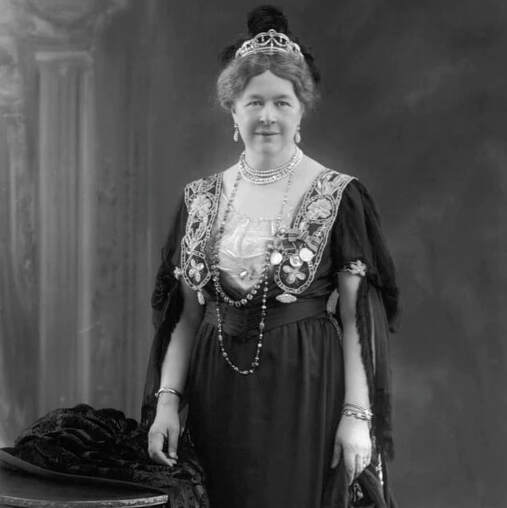ISHBEL MARCHIONESS OF ABERDEEN AND TEMAIR (1857-1939)

Ishbel Maria Hamilton-Gordon, Marchioness of Aberdeen and Temair, GBE was one of the towering figures of North-East life between the 1870s and the 1930s. She was a campaigner for women's rights in education, and suffrage. With her husband, John 7th Earl and 1st Marquess of Aberdeen and Temair (1847-1934) she formed the formidable double act know universally as We Twa.
Hon Ishbel Maria Majoribanks was born in London, on 15 March 1857, the third daughter of the 1st Lord Tweedmouth and his wife, Isabella Weir-Hogg (daughter of Sir James Weir Hogg). The family divided their time between London and the mansion house of Guisachan in Glen Affric. Ishbel received a well-rounded and liberal education in English, French, mathematics, history and geography. She was recommended for further study by her tutors, but Lord Tweedmouth did not believe that women should not attend universities or colleges. Whilst still at home, she attended many social gatherings and mixed with many of the most famous political and society figures of her day. In particular, she forged strong political views (Liberal) and was also strongly evangelical in her outlook believing that she must devoted her life to good works, social reform, and upholding moral rectitude.
After a six-year acquaintance, she married John Campbell Hamilton-Gordon, the 7th Earl of Aberdeen on 7 November 1877 in St. George's Church, St. George Street, Hanover Square, London. The couple had four surviving children: George (Doddie) born 1879, (who became the 2nd Marquess of Aberdeen and Temair), Marjorie born 1880 (later Lady Pentland), Dudley born 1883 (from whom the present Marquess of Aberdeen and Temair descends) and Archibald in 1884. Marjorie, Lady Pentland, Lady Aberdeen's daughter, wrote that "Ishbel interpreted the duty of wife as one who not only provided for her husband a serene background in private life, but as one who also thought and fought for him in all his affairs".
Their principal home was Haddo House, which Lady Aberdeen extensively modernised and renovated. It was in Aberdeenshire that she started her involvement in social reform. She organised a Household Club that held classes for servants to learn singing, carving, reading, and other activities. The Aberdeens often attended their servants’ evening socials and meetings, and in London society it was rumoured that they had even dined together. Although this was one of many scurrilous rumours that had not truth. They also funded a local school and hospital—healthcare was a cause that Lady Aberdeen supported throughout her life.
Ishbel established the Onwards and Upward Association, which provided servant girls with postal courses on topics ranging from geography to literature to domestic science. This scheme spread from Aberdeenshire to include thousands of servants across the United Kingdom. She founded the Aberdeen Ladies' Union, an institution to help young women in Scotland. In 1883 she became the first president of the Ladies’ Union of Aberdeen, an organization that focused on the well-being of young women living in cities. An Emigration Committee chose suitable women and sponsored them to move to the colonies, especially Canada where Johnny was to serve as Governor-General. Lady Aberdeen was also the head of the Women's Liberal Federation, which advocated for women's suffrage.
The Aberdeens served in Canada between 1893 and 1896. Ishbel was more politically involved than her predecessors. She hosted many popular social events, such as winter festivals and costume balls, and travelled extensively, attending events and collecting information for her husband. She regularly offered him advice, and in fact newspapers commented (sometimes critically) that it appeared she held the power in their relationship. Lady Aberdeen was the first president of the International Council of Women, an organisation that campaigns for women's rights. She was involved in chairing many organisations devoted to women's education and healthcare during her time in Canada.
The Aberdeen's had a long second term as Viceroy and Vicereine of Ireland between 1906 and 1915 (having briefly held the same post in the 1880s). It was a period marked by strong Irish nationalism and Ishbel, who had been popular during their first term, was not always as sensitive to Irish sentiments as she could be. She focused her time on healthcare and social well-being, being involved with medical organizations like the Women's National Health Association of Ireland which was dedicated to treating and preventing tuberculosis and improving children's health. She served as the first president of the Housing and Town Planning Association of Ireland, advocating for better housing and public spaces to address the prevalent poverty. Lady Aberdeen's Cottages in Mullingar are named after her.
Johnny was raised to become Marquess of Aberdeen and Temair in 1916. They settled in retirement at House of Cromar at Tarland, an extensive property they had built for themselves. The couple had, however, gone through their extensive fortunate (mostly in support of good causes) and the estates at Haddo and Cromar were effectively bankrupt. Cromar was sold to the MacRobert family although John and Ishbel continued to live there until his death in 1934. Lady MacRobert took possession of the house and its contents with almost indecent haste. Queen Mary intervened and bought a much-loved secretaire from Lady MacRobert which she gave back to Ishbel.
Ishbell was invested with the Grand Cross of the Order of the British Empire (GBE) in 1931. Robert Gordon University has building named Ishbel Gordon in here honour. Various plaques have been erected to her in Canada. She died in Aberdeen in 1939.
Entry written by Peter Reid
Further reading.
Strong-Boag, Veronica (2015). Liberal Hearts and Coronets: The Lives and Times of Ishbel Marjoribanks Gordon and John Campbell Gordon, the Aberdeens. University of Toronto Press.
Welfare, Simon (2021). Fortune's many houses. Atria Books.
Hon Ishbel Maria Majoribanks was born in London, on 15 March 1857, the third daughter of the 1st Lord Tweedmouth and his wife, Isabella Weir-Hogg (daughter of Sir James Weir Hogg). The family divided their time between London and the mansion house of Guisachan in Glen Affric. Ishbel received a well-rounded and liberal education in English, French, mathematics, history and geography. She was recommended for further study by her tutors, but Lord Tweedmouth did not believe that women should not attend universities or colleges. Whilst still at home, she attended many social gatherings and mixed with many of the most famous political and society figures of her day. In particular, she forged strong political views (Liberal) and was also strongly evangelical in her outlook believing that she must devoted her life to good works, social reform, and upholding moral rectitude.
After a six-year acquaintance, she married John Campbell Hamilton-Gordon, the 7th Earl of Aberdeen on 7 November 1877 in St. George's Church, St. George Street, Hanover Square, London. The couple had four surviving children: George (Doddie) born 1879, (who became the 2nd Marquess of Aberdeen and Temair), Marjorie born 1880 (later Lady Pentland), Dudley born 1883 (from whom the present Marquess of Aberdeen and Temair descends) and Archibald in 1884. Marjorie, Lady Pentland, Lady Aberdeen's daughter, wrote that "Ishbel interpreted the duty of wife as one who not only provided for her husband a serene background in private life, but as one who also thought and fought for him in all his affairs".
Their principal home was Haddo House, which Lady Aberdeen extensively modernised and renovated. It was in Aberdeenshire that she started her involvement in social reform. She organised a Household Club that held classes for servants to learn singing, carving, reading, and other activities. The Aberdeens often attended their servants’ evening socials and meetings, and in London society it was rumoured that they had even dined together. Although this was one of many scurrilous rumours that had not truth. They also funded a local school and hospital—healthcare was a cause that Lady Aberdeen supported throughout her life.
Ishbel established the Onwards and Upward Association, which provided servant girls with postal courses on topics ranging from geography to literature to domestic science. This scheme spread from Aberdeenshire to include thousands of servants across the United Kingdom. She founded the Aberdeen Ladies' Union, an institution to help young women in Scotland. In 1883 she became the first president of the Ladies’ Union of Aberdeen, an organization that focused on the well-being of young women living in cities. An Emigration Committee chose suitable women and sponsored them to move to the colonies, especially Canada where Johnny was to serve as Governor-General. Lady Aberdeen was also the head of the Women's Liberal Federation, which advocated for women's suffrage.
The Aberdeens served in Canada between 1893 and 1896. Ishbel was more politically involved than her predecessors. She hosted many popular social events, such as winter festivals and costume balls, and travelled extensively, attending events and collecting information for her husband. She regularly offered him advice, and in fact newspapers commented (sometimes critically) that it appeared she held the power in their relationship. Lady Aberdeen was the first president of the International Council of Women, an organisation that campaigns for women's rights. She was involved in chairing many organisations devoted to women's education and healthcare during her time in Canada.
The Aberdeen's had a long second term as Viceroy and Vicereine of Ireland between 1906 and 1915 (having briefly held the same post in the 1880s). It was a period marked by strong Irish nationalism and Ishbel, who had been popular during their first term, was not always as sensitive to Irish sentiments as she could be. She focused her time on healthcare and social well-being, being involved with medical organizations like the Women's National Health Association of Ireland which was dedicated to treating and preventing tuberculosis and improving children's health. She served as the first president of the Housing and Town Planning Association of Ireland, advocating for better housing and public spaces to address the prevalent poverty. Lady Aberdeen's Cottages in Mullingar are named after her.
Johnny was raised to become Marquess of Aberdeen and Temair in 1916. They settled in retirement at House of Cromar at Tarland, an extensive property they had built for themselves. The couple had, however, gone through their extensive fortunate (mostly in support of good causes) and the estates at Haddo and Cromar were effectively bankrupt. Cromar was sold to the MacRobert family although John and Ishbel continued to live there until his death in 1934. Lady MacRobert took possession of the house and its contents with almost indecent haste. Queen Mary intervened and bought a much-loved secretaire from Lady MacRobert which she gave back to Ishbel.
Ishbell was invested with the Grand Cross of the Order of the British Empire (GBE) in 1931. Robert Gordon University has building named Ishbel Gordon in here honour. Various plaques have been erected to her in Canada. She died in Aberdeen in 1939.
Entry written by Peter Reid
Further reading.
Strong-Boag, Veronica (2015). Liberal Hearts and Coronets: The Lives and Times of Ishbel Marjoribanks Gordon and John Campbell Gordon, the Aberdeens. University of Toronto Press.
Welfare, Simon (2021). Fortune's many houses. Atria Books.



